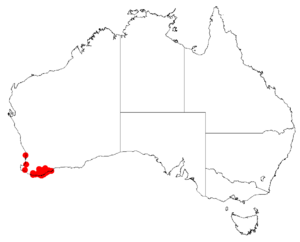Isopogon longifolius facts for kids
Quick facts for kids Isopogon longifolius |
|
|---|---|
| Scientific classification | |
| Genus: |
Isopogon
|
| Species: |
longifolius
|
 |
|
| Occurrence data from Australasian Virtual Herbarium | |
| Synonyms | |
|
Atylus longifolius (R.Br.) Kuntze |
|
Isopogon longifolius is a small shrub in the family Proteaceae that is endemic to the southwest of Western Australia.
Description
Isopogon longifolius is a small shrub (1-2.5 m high) with smooth branchlets. The smooth, flat leaves are alternate, and 85–220 mm long, and 6–30 mm wide. They are widest above the middle, and have smooth edges. The cream/yellow inflorescence is not sticky. The hairy perianth 13–15 mm long. The pistil is 15–20 mm long and the pollen presenter is spindle-shaped and smooth (2.5-3.5 mm long). The cone has deciduous scales, and is 24–28 mm long. It flowers in January, October, November or December.
Taxonomy
The species was first formally described by botanist Robert Brown in Transactions of the Linnean Society of London in 1810. In 1891, German botanist Otto Kuntze published Revisio generum plantarum, his response to what he perceived as a lack of method in existing nomenclatural practice. Because Isopogon was based on Isopogon anemonifolius, and that species had already been placed by Richard Salisbury in the segregate genus Atylus in 1807, Kuntze revived the latter genus on the grounds of priority, and made the new combination Atylus longifolius for this species. However, Kuntze's revisionary program was not accepted by the majority of botanists. Ultimately, the genus Isopogon was nomenclaturally conserved over Atylus by the International Botanical Congress of 1905.
The accepted description for Isopogon linearis is that of Foreman (1995) in Flora of Australia.

